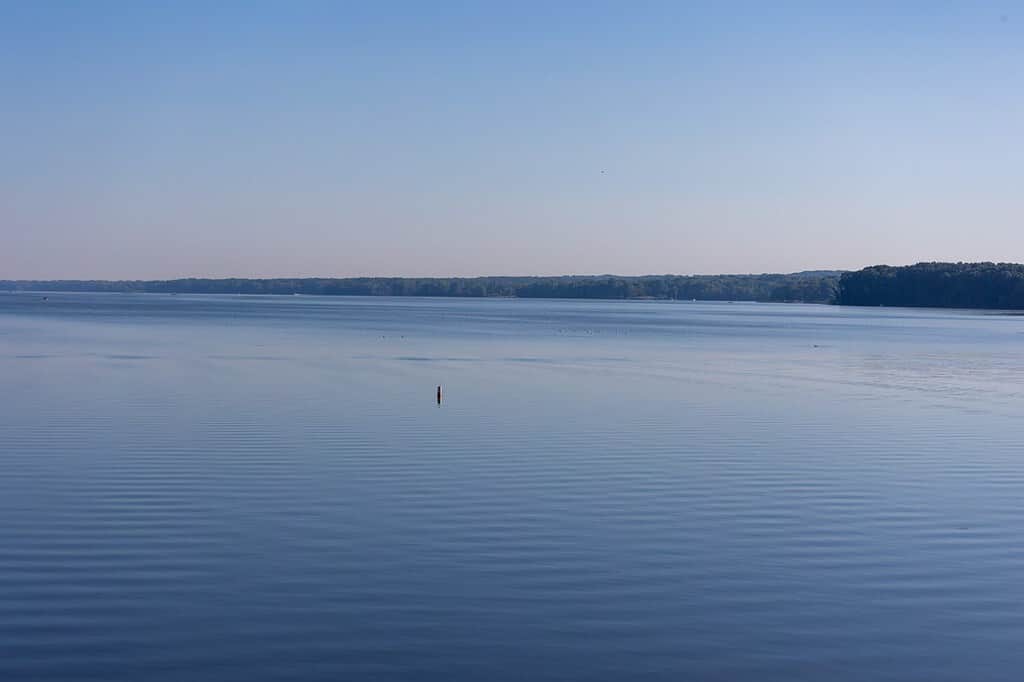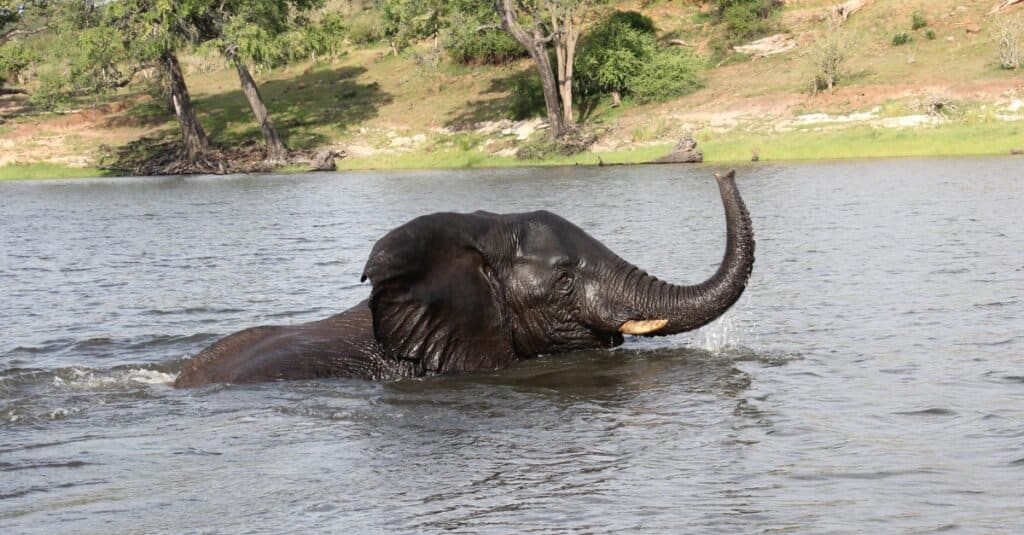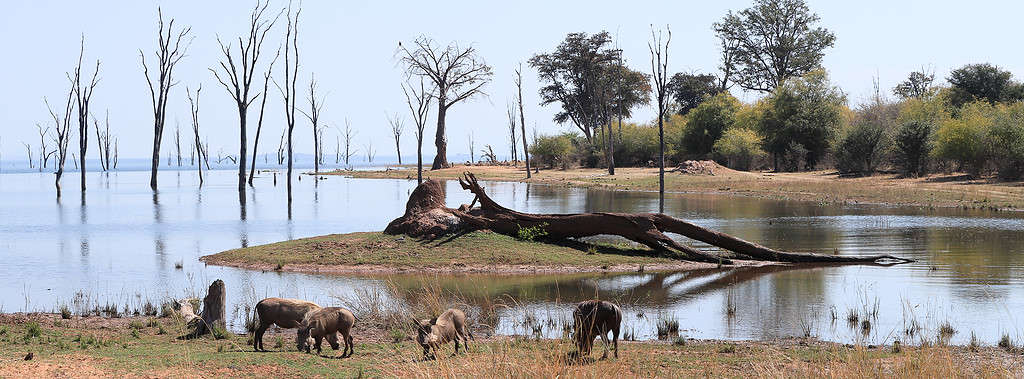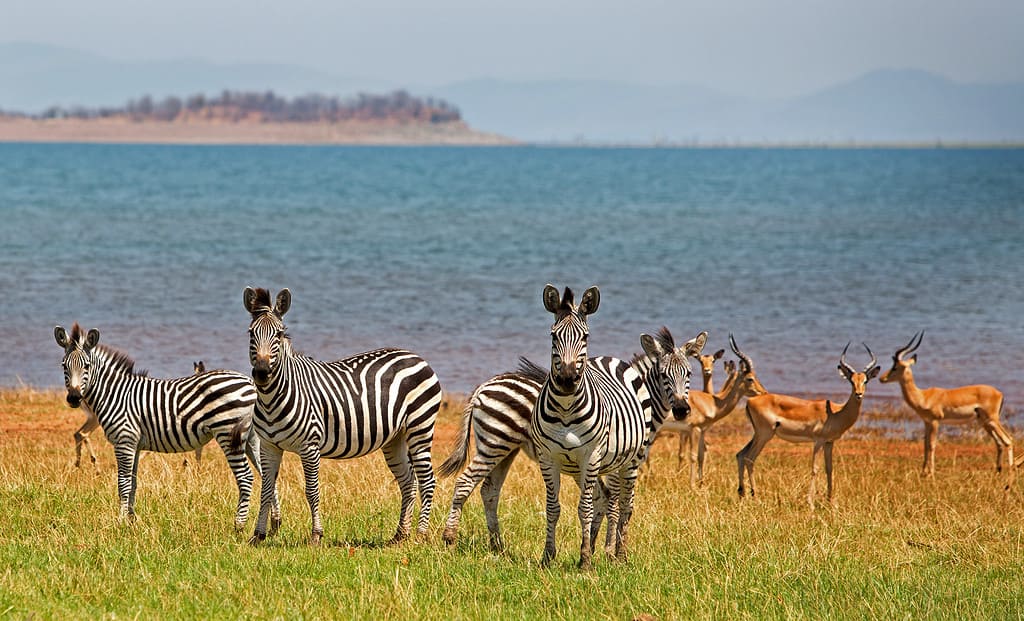Lake Kariba has the distinction of being the world’s largest man-made lake. It’s located on the Zimbabwe and Zambia border. Indeed, few of the largest man-made lakes in the United States come close to its size.

However, beyond the massive dimensions of Lake Kariba is the other fascinating fact that a large population of hippos and crocodiles infest the lake. Indeed this is an interesting case of prey and predator sharing the same environment and managing to co-exist.
Let’s peel back the fascinating layers of Lake Kariba from its inception to the present day. Join us as we find out why it provides such a hospitable refuge for hundreds of animal species.
Lake Kariba: The Beginning
The motive behind the construction of Lake Kariba was to provide hydroelectric energy for the bordering countries, Zimbabwe and Zambia. The renowned French dam specialist Andre Coyne came up with the concept for the dam. His Wikipedia profile shows that he designed a staggering 70 dams in 14 countries throughout his career. He became famous in the industry for his Arch dam designs.
Unfortunately, a dam collapse in Southern France’s Malpasset Dam marred his reputation. Four hundred twenty-three people died when the water flooded Frejus, a nearby town, in 1959. Coyne took responsibility for the accident and died approximately six months later. Ironically, further investigation showed that he might have, after all, not been solely responsible for the dam collapse. This is a tragic tale from someone who gave the world the remarkable artificial reservoir that boasts rights as the largest man-made lake.
There were some significant concerns around the construction of the Kariba Dam. They included:
- Inundation of vast areas of scrubland.
- The loss of habitats of thousands of animals and possibly lives.
- Relocation of local villages, thus significant disruption to the people living in the Zambezi floodplain.
However, after careful analysis, the authorities were convinced that a dam would provide more benefits than losses.

This large crocodile has made Lake Kariba its home, enjoying the African sunshine while taking in the breathtaking beauty of this large lake.
©Martin Mecnarowski/Shutterstock.com
Construction of the Dam
The first step in the construction of Kariba Dam began with clearing vegetation. The easiest method was burning, which resulted in a mineral-rich lake.
The construction of the 36.6-meter-high wall started in 1956 and took three years to complete. The significant wall thickness ensured that it could adequately handle the massive pressure of water going through the spillway every second. Filling of the dam started in 1958 with the closing of the sluice gates. It took another five years for the dam to achieve maximum water levels.
The salient features of the artificial lake are as follows:
- Exact location – Halfway down Zambezi River, approximately 81 miles southwest of Zambia’s capital Lusaka. If you approach it from Harare, the capital city of Zimbabwe, you will travel 175 km northwest.
- Coordinates – 16.9557degrees south latitude and 27.9718 degrees east longitude
- Height – 420 ft.
- Length – 1,900 feet
- Base width – 105 feet
- Crest width – 30 feet
- Crest – 1,899 feet
- The volume of concrete used in the construction: 1,830,000 cubic meters
- Reservoir surface area – 5400 square kilometers
- Reservoir capacity – 185 billion cubic meters
- Upstream extension to Devil’s Gorge – 175 miles
- Electricity generated by the dam – 6,700,000,000 KW
Origin of Lake Kariba Name
Kariba, or Kariva as the locals refer to it, was the name of a rock at the gorge entrance. What made the Rock special to the Tonga locals was its association with the great river god, Nyaminyami. They believed that was the dwelling place of the god.
Interestingly, Nyaminyami, a half-fish, half-snake being, would drown anyone who ventured near its home. When the flooding of the dam, and indeed Nyaminyami’s home, occurred, the locals were distraught, so much so that they attributed construction failures to the gods’ displeasure.
Take the example of the 1957 floods that destroyed access roads and equipment. The following year, another surge of a similar magnitude destroyed the access bridge and parts of the dam’s main wall.
Operation Noah to the Animals Rescue
If you’re familiar with the biblical story of Noah and The Ark, you will have a good idea of the operation.
The attendant cost of the construction of Kariba Dam was its impact on wildlife and people. The Rhodesian Department of National Parks and Wildlife Management had a solution for the former. A large-scale animal rescue dubbed Operation Noah took place between 1958 and 1964. At the forefront of the rescue mission was Rupert Fothergill.
The operation targeted animals in the flooded areas courtesy of the Kariba dam construction. This included different species, such as baboons, lions, elephants, zebras, and antelopes. The main tools of trade for the operation were helicopters, trucks, and boats.
Operation Noah was a massive success, with over 6,000 animals finding homes in Sioma Ngwezi and Matusadona National Parks in Zambia and Zimbabwe, respectively. Unfortunately, a large number of animals sacrificed their lives in the construction of the dam.

An aerial shot of Lake Kariba – a manmade lake created by damming the Zambe River. It’s home to a rich variety of aquatic life and offers stunning views for visitors.
©Aqeela_Image/Shutterstock.com
What is the Ecology of Lake Kariba?

African elephants enjoy swimming in and drinking from Lake Kariba.
©iStock.com/Masixole Msumza
When Lake Kariba was first filled, the water contained a high level of nutrients because of the vegetation that had decomposed and been submerged. This led to a productive layer of soil forming on the lakebed. Consequently, this has created a dynamic ecology in the lake. Several fish species have been introduced, including the kapenta fish, which is abundant in Lake Tanganyika.
Lake Kariba in Africa is a thriving habitat for fish that you can catch and eat, such as tigerfish, which was originally from the Zambezi River. Locals are attempting to make the lake a tourist destination due to the fish found there. In addition, many birds, such as African fish eagles and cormorants, enjoy eating fish from this lake. Lots of land animals use the lake as a watering hole. You can see elephants, lions, leopards, cheetahs, buffalo, and other small animals on the shorelines. There used to be black and white rhinoceros, but poaching has killed most of them.
Why Does Kariba Dam Attract Wildlife?
Kariba Dam is home to a diverse array of wildlife. The lake and surrounding areas host fish, birds, reptiles, and mammals. There was also a concerted effort by the authorities to introduce shoals of Kapenta fish, which resemble sardines, to the lake. Over the years, they raised more fish species, contributing to the formation of a booming commercial fishing economy in the area.
So why does Kariba Dam attract wildlife? Here are two major reasons:
- The lake’s size and position within a relatively dry region: To this end, the animals are sure of food and water, even when other areas are experiencing drought.
- Conservation measures by national parks that aim at restoring wildlife habitats: A good example would be Matusadona National Park, which gave animals refuge after Operation Noah.
Of special note is the large population of crocodiles and hippos infesting the waters.
The hippos prefer to live in large groups along the shorelines in shallow areas. The constant food and water supply further gives them an excellent reason to stay. Lush vegetation and grass mean they enjoy a consistent supply of nutritious foods.
The Kariba Dam crocodiles grow to immense proportions with good reason. Thus, the food supply is abundant, and the water provides a home and nesting sites.
What You Should Know About the Kariba Hippos and Crocodiles
Kariba Dam continues to draw thousands of visitors every year. The tons of activities, which we will explore later, are a major draw. So, if you’re planning a visit, note the following points on the Kariba Hippos and Crocodiles. You should be aware that it could mean the difference between life and a very tragic and painful demise.
Aggression
Despite their appearance, hippos are relatively peaceful creatures, preferring to avoid humans altogether. But, and this is a big BUT, they can immediately become aggressive if they feel that your presence is threatening them in any way.
And don’t let the hippos’ massive size fool you. On average, a hippo can achieve 30 mph. Now here’s the interesting part: its gait resembles that of a horse, as it gallops when in fast movement. That could explain where it got the name River Horse. It’d be highly misleading to think you can outrun a hippo on dry land.
Conversely, crocodiles have a mean temper and are always on the lookout for food. Knowing this, please avoid this carnivore at all costs. You may have read that the freshwater crocodile is almost harmless, but take note of the word ‘almost.’
Movement in Water
Both the hippos and crocodiles are powerful swimmers. They can also hold their breath underwater longer than you can. For instance, crocodiles can stay submerged for almost two hours. Adult hippos can manage five minutes. So suffice it to say you want to avoid getting into a water survival competition with either animal.
The Kariba Dam Animals Enjoy State Protection
Hunting, trapping, or harming the animals at Kariba Dam is strictly forbidden. As stated earlier, the area lies in conservation areas and thus enjoys state protection. Penalties for breaking the laws vary depending on the severity of the infraction, game type, and more. You can face imprisonment, fines, or both.
You’ll need a hunting license before going about your hunting escapades. Get in touch with the Zambia and Zimbabwe Departments of National Parks to register for one. They will give you guidelines and regulations on accepted practices. CITES permits are necessary for some animal species. You must also have a temporary firearm license.
One of the most popular hunting areas is Gache Gache, on the eastern basin of Lake Kariba. The area has a massive population of elephants, hippos, crocodiles, and leopards.
We recommend booking hunting expeditions with companies that offer hunt safaris. They can walk you through and arrange for some of the requirements.

Warthogs gather in large numbers at the banks of Lake Kariba, Zimbabwe – and can often be seen wallowing in the shallow waters or on the grassy shore.
©iStock.com/Hugo TORRES
Can You Swim In Lake Kariba?
Who’d want to pass up a chance to take a dip in Lake Kariba? There’s no law that prohibits you from swimming in the dam. As you do that, however, be careful that you don’t bump into hippos or crocodiles on the shoreline for obvious reasons.
Furthermore, because parasites like Bilharzia thrive in spots like these, you run the risk of contracting waterborne infections, which would be an unfortunate end to your visit. Keep an eye out for algae blooms in the water as well. Some people experience adverse reactions upon contact, which leads to major skin irritation.
So, if the urge to get into the water is so strong, go into the deeper waters. You’ll, of course, need a boat to reach such depths. Now here is the challenge, though. It is not uncommon for crocodiles to swim across the length of the dam. So, avoid bumping into one by taking advantage of the swimming cages that some tour companies have.
Allow us to emphasize one point. Swimming alone in Lake Kariba makes it to the list of ‘1000 ways to die.’ And no, we don’t mean to be pessimistic. That said, please take due precaution if you really must dip in the waters. In a hippo/crocodile battle, the odds won’t likely be in your favor. The same caution applies to other water activities like kayaking, water/jet skiing, or wakeboarding.
Fun Activities at Lake Kariba
Thousands of visitors throng Lake Kariba every year. Unfortunately, there has been a significant decline in tourist numbers. Despite this, the authorities are taking relevant measures to revive tourism within the area. With that said, let’s explore the factors that make Lake Kariba such a fun destination, shall we?
Plenty of Wildlife for Animal Lovers
One of the most prolific attractions in Lake Kariba is the vast array of animal species. Seeing the magnificent creatures in their natural element and environment is a pleasure many people would wish for. Bird watching is another much-loved activity at Lake Kariba.
Please remember to charge your camera and other picture-taking smart devices. We bet you’ll be taking plenty of pictures!
Stunning Sceneries
One word to describe the Kariba Dam vistas is stunning. On one side, you have a plunging drop into a gorgeous gorge. On the other is calm, turquoise blue waters. And then, like out of a painting, are bare limbs of drowned trees seemingly reaching for the sky. Catch that scenery in the fading evening lights and be blown away by the indescribable beauty.
Fishing and Boat Cruises
The high marine life population makes Kariba Dam an excellent choice for fishing enthusiasts. Tiger fishing takes the top spot as one of the most challenging yet rewarding pastimes. If you’re up to the challenge, plan your visit to Lake Kariba in October for the Kariba International Tiger Fish Tournament.
Get the whole nature experience by signing up for the boat cruises on Lake Kariba. This is a fun way to socialize while fishing or simply laying back and viewing the wildlife.
Sign Up for the Safaris
There are plenty of safari areas to explore; here are some of them:
- Matusadona National Park, which we’ve referenced quite a bit in this article.
- Chete safari area for controlled hunting.
- Islands of Kariba, including Maaze Island, Mahsape Island, and Sekula Island, all in Zambia. In Zimbabwe, you can visit Sampa Kauma, Fothergill (named after Noah’s Operation leader), Starvation Island, Bed Island, and Antelope Island.
- Binga and Siavonga towns in Zimbabwe and Zambia. The towns hosted the dam construction crews and the displaced Tonga people. There is a lot of culture, tradition, and Kariba Dam folklore to enthrall you during your visit.
- Guided tours for a cultural experience with the locals. That presents a fantastic opportunity to learn about the people and the dam’s history.

The majestic wildlife that call the banks of Lake Kariba home, including these zebras and impalas, is an unforgettable sight. It’s no wonder it draws in fans of nature from all over the world.
©iStock.com/paulafrench
Kariba Dam: A Man-Made Wonder That Continues To Amaze
If Andre Coyne was to come back to life, he’d probably be shocked at how impactful Kariba Dam has been. What started as a simple dam to harness electricity is now home to thousands of plant and animal species. Predators and prey live in perfect harmony, as is the case with hippos, crocodiles, and other animals.
Beyond that is the number of visitors who visit the dam for recreational purposes. Wildlife viewing, bird watching, cruises, fishing and cultural attractions are significant draws.
Where is Lake Kariba Located on a Map?
Lake Kariba, situated on the border between Zambia and Zimbabwe, holds the distinction of being the largest man-made lake and reservoir in the world in terms of volume. Located approximately 1,300 kilometers upstream from the Indian Ocean, it stands as a remarkable feat of engineering.
Here is Lake Kariba on a map:
Thank you for reading! Have some feedback for us? Contact the AZ Animals editorial team.








